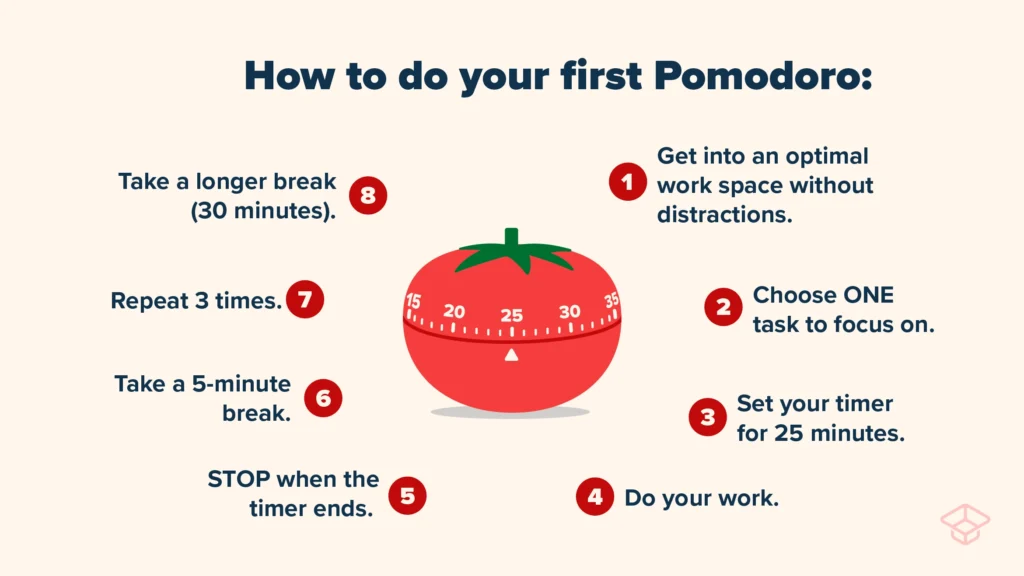
In an age of constant distractions and multitasking, finding effective methods to enhance productivity has become more crucial than ever. The Pomodoro Technique, a time management approach developed by Francesco Cirillo in the late 1980s, offers a structured yet flexible strategy for optimizing focus and productivity. In this article, we’ll delve into the principles, benefits, and practical applications of the Pomodoro Technique.
Understanding the Pomodoro Technique
The Pomodoro Technique is a time management method that employs focused work intervals, known as “Pomodoros,” followed by short breaks. The method takes its name from the Italian word for “tomato,” inspired by the kitchen timer shaped like a tomato that Cirillo used during his university years. Each Pomodoro typically consists of 25 minutes of concentrated work, followed by a 5-minute break. After completing four Pomodoros, a longer break of 15-30 minutes is taken.
The Science Behind the Technique
The Pomodoro Technique is rooted in principles of psychology and neuroscience that explain its effectiveness:
Focused Attention
The technique capitalizes on the brain’s ability to maintain focused attention for a limited period. The 25-minute work interval aligns with the brain’s natural attention span, preventing mental fatigue and maintaining optimal focus.
Interval Training for the Brain
Just as physical workouts benefit from intervals of exertion and rest, cognitive tasks also benefit from structured intervals. The short breaks between Pomodoros provide mental rejuvenation and prevent burnout.
Benefits of the Pomodoro Technique
The Pomodoro Technique offers numerous advantages that contribute to increased productivity and overall well-being:
Enhanced Focus
By dedicating a fixed time to a single task, the technique minimizes distractions and multitasking, allowing for deep concentration.
Improved Time Management
Structured work intervals encourage task prioritization and help individuals allocate time more efficiently.
Increased Efficiency
The time constraint encourages individuals to work with purpose, complete tasks, and make progress toward larger goals.
Reduced Procrastination
Breaking tasks into manageable intervals makes them seem less daunting, reducing the likelihood of procrastination.
Prevention of Burnout
Regular breaks prevent mental exhaustion and promote sustainable work habits.
Implementing the Pomodoro Technique
To effectively apply the Pomodoro Technique, follow these steps:
Choose a Task
Select a task you want to complete. Break larger tasks into smaller, achievable portions.
Set the Timer
Set a timer for 25 minutes, the duration of one Pomodoro.
Work Intensely
Focus exclusively on the chosen task during the Pomodoro, avoiding distractions.
Take a Short Break
When the timer rings, take a 5-minute break. Stand, stretch, or engage in a brief, unrelated activity.
Repeat and Track
After each break, begin another Pomodoro. After completing four Pomodoros, take a longer break.
Tips for Success
Adapt to Your Rhythm
Adjust the length of intervals based on your attention span and energy levels.
Customize Intervals
Experiment with Pomodoro lengths to find the optimal interval that suits your concentration levels.
Prioritize Tasks
Start with the most important tasks during the first Pomodoro of the day.
Minimize Interruptions
Inform colleagues or family members about your Pomodoro schedule to reduce interruptions.
Stay Consistent
Consistency is key. Practice the technique regularly to develop a productive routine.
Conclusion
The Pomodoro Technique offers a structured and scientifically grounded approach to time management and productivity enhancement. By leveraging the brain’s natural attention cycles, this technique helps individuals work with focus, efficiency, and balance, ultimately contributing to greater accomplishments and improved well-being. Incorporating the Pomodoro Technique into your daily routine can lead to a transformative shift in your productivity and work habits.